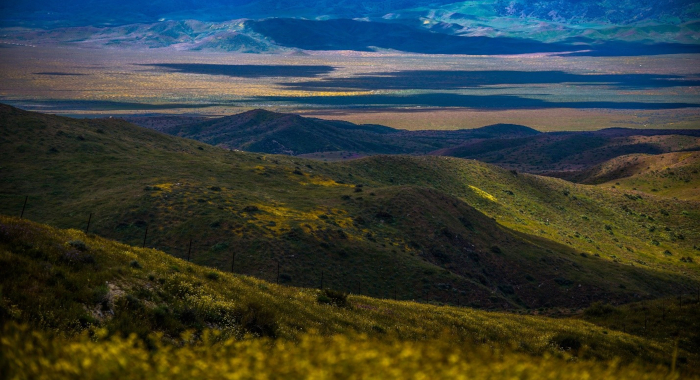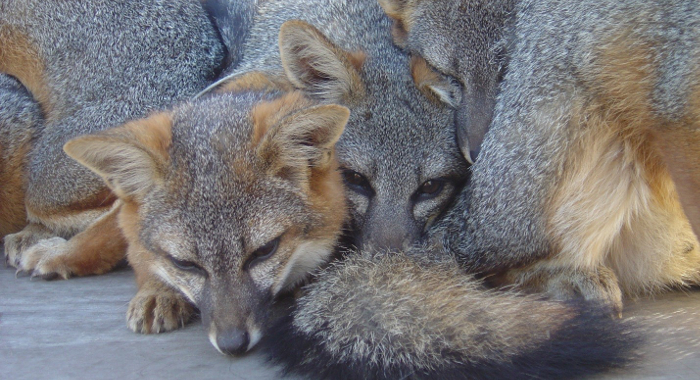Nearly half of California is protected in some land status that prevents most kinds of intensive human land uses. These lands support extensive natural habitats, and for many species, are a critical stronghold in an increasingly human-dominated world.
Yet, changes in the landscape in and near these places have left many in a degraded and precarious condition. Catastrophic wildfire, invasive species, and climate change threaten vast swathes of the state. Protected lands are becoming increasingly isolated by urban and agricultural development, roads, and other infrastructure. Such obstacles can limit a species’ ability to move to across the landscape and adapt to climate change.
Conservancy scientists are working to enhance the resiliency of protected lands in the face of rapid change, and to maintain the landscape connections necessary for plants and animals to adapt over time.


H. Scott Butterfield (TNC), Jeanette K. Howard (TNC), Daniel Toews (TNC), Abigail Hart (TNC), Kathy Wood-McLaughlin
To meet the goals of California's 2014 Sustainable Groundwater Management Act (SGMA), more than 500,000 acres of irrigated agricultural land will need to be retired. TNC and partners…Lara J. Brenner, Nathaniel Rindlaub, Juliana Matos, Scott Meyler, Sue Pollock, Falk Schuetzenmeister, Nick D. Holmes
Invasive mammals like rats pose a major threat to island ecosystems and endemic species. This study tests a wireless camera network on Santa Cruz Island that uses AI to detect nonnative mammals in…Alexandra L. DeCandia, Jasmine Lu, Emily E. Hamblen, Lara J. Brenner, Julie L. King, Calypso N. Gagorik, Juliann T. Schamel, Stacy S. Baker, Francesca J. Ferrara, Melissa Booker, Andrew Bridges, Cesar Carrasco, Bridgett M. vonHoldt, Klaus-Peter Koepfli, Jesús E. Maldonado
Isolated island species may be more susceptible to disease because of their lack of genetic diversity. Santa Catalina Island foxes have the highest rate of cancer ever measured in wildlife - over 50%…Alexander L. Metcalf, Elizabeth Covelli Metcalf, Lara J. Brenner, Holly K. Nesbitt, Conor N. Phelan, Michael S. Lewis, Justin A. Gude
The long-term survival of large carnivores like wolves, grizzly bears and mountain lions depends not just on ecological factors like habitat, but also on social factors like human acceptance of their…Lara J. Brenner, Piper D. Wallingford, Nick D. Holmes, John J. Knapp, John M. Randall, Scott A. Morrison
Island ecosystems are especially vulnerable to climate change, yet planning for these impacts remains challenging due to a lack of available data. This paper reports on a collaborative workshop across…Samantha Pasciullo Boychuck, Lara J. Brenner, Calypso N. Gagorik, Juliann T. Schamel, Stacy Baker, Elton Tran, Bridgett M. vonHoldt, Klaus-Peter Koepfli, Jesús E. Maldonado, Alexandra L. DeCandia
On California’s Channel Islands, two rare carnivores—the island fox and island spotted skunk—have coexisted for millennia despite competing for similar resources. This study explores…Bruce Markman, H. Scott Butterfield, Janet Franklin, Lloyd Coulter, Moses Katkowski, and Dan Sousa
Residual dry matter has been widely used to monitor grazing impacts across conservation grazing lands for more than 75 years, largely done with time-intensive, expensive, and hard-to-reproduce…Golet G.H., Kristen E. Dybala, Joeseph G. Silvera, Adam Henderson, Jennifer Isola, David H. Wright, Ron Melcer Jr., and Danika Tsao.
Lowland alluvial rivers are rich in biodiversity, yet many are highly degraded and no longer support robust natural communities. Over the past few decades, Bank Swallows, which depend upon these…Michael J Clifford, Peter Gower, Tanya Anderson, Jaina Moan, Mickey Hazelwood, Sophie S Parker, Laurel Saito
Dramatic changes to the transportation and energy sectors are required to reduce greenhouse gas emissions and meet the goal of keeping global average temperatures from rising. The authors discuss how…Carrie A. Schloss, D. Richard Cameron, Bradley Franklin, Christoph Nolte, Scott A. Morrison
In response to biodiversity declines worldwide, over 190 nations committed to protect 30% of their lands and waters by 2030 . As these jurisdictions move from planning to implementation, we propose a…Erin. E. Conlisk, Gregory H. Golet, Mark D. Reynolds, Nathan Elliot. and Matthew E. Reiter
Shorebirds are the second fastest declining group of birds in North America. To reverse this trend, The Nature Conservancy has been implementing BirdReturns, a habitat incentive program that pays…William T. Bean, H. Scott Butterfield, Jeanette K. Howard, Thomas J. Batter
In this paper, the authors used a variety of habitat suitability modeling approaches to begin to understand where pronghorn may exist in the future in California under different climate change…Lucy Genua, Brad Anderson, Meghan Bowen, Genelle Ives, Owen Liu, Thomas Paschos, H. Scott Butterfield, Kelly Easterday, Mark Reynolds, James H. Thorne
In this paper, the authors used historical vegetation data, from both aerial photographs and field transects, to assess the change in major vegetation types at the Dangermond Preserve over the last…Michael J. Clifford, Sophie S. Parker, Laurel Saito, Brian S. Cohen, Naomi S. Fraga
Lithium batteries are important for the clean energy transition in the United States because they are used in electric vehicles and for grid power storage. However, lithium extraction may have impacts…Nicholas A. Povak, Patricia N. Manley, Kristen N. Wilson
This study presents a methodology to integrate spatial assessments of current and future forest conditions to understand the potential to achieve desired conditions under climate change with ongoing…Sophie S. Parker, Michael J. Clifford, Brian S. Cohen
To address climate change, the United States is incentivizing the production of electric vehicles containing domestically derived lithium batteries. Extracting this lithium may have environmental…Michael Clifford, Sophie Parker, Matt Rader, Lydia Bailey, Naomi Fraga, Chris Hass, Estella Hernandez, Jan Kempf, Lois Merkler, Michael Swink
The Amargosa River supports one of the most outstanding suites of endemic and imperiled species in the world. In 2019, TNC acquired the Atwood Preserve in the river’s headwaters, the…